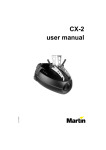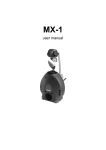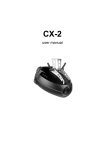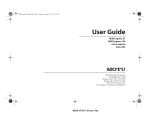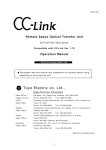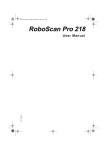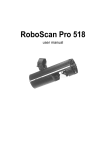Download Martin SynchroZap QX250 User manual
Transcript
SynchroZap QX250 P/N 35000025 User Manual © 1998, 1999 Martin Professional A/S, Denmark. All rights reserved. No part of this manual may be reproduced, in any form or by any means, without permission in writing from Martin Professional A/S, Denmark. Printed in Denmark. P/N 35000025, Rev. B section 1 INTRODUCTION Thank you for selecting the Martin SynchroZap QX250. This manual covers the SynchroZap QX250 with CPU software version 1.1. For the latest product news and documentation, please contact your dealer or the Martin web site at http://www.martin.dk. SynchroZap QX250 safety information WARNING! This product is for professional use only. It is not for household use. This product presents risks of lethal or severe injury due to fire and heat, electric shock, ultraviolet radiation, lamp explosion, and falls. Read this manual before powering or installing the fixture, follow the safety precautions listed below and observe all warnings in this manual and printed on the fixture. If you have questions about how to operate the fixture safely, please contact your Martin dealer or call the Martin 24-hour service hotline at +45 70 200 201. To p r o t e c t y o u r s e l f a n d o t h e r s f r o m e l e c t r i c s h o c k • Disconnect the fixture from AC power before removing or installing the lamp, fuses, or any part, and when not in use. • Always ground (earth) the fixture electrically. • Use only a source of AC power that complies with local building and electrical codes and has both overload and ground-fault protection. • Do not expose the fixture to rain or moisture. • Refer service to a qualified technician. There are no user-serviceable parts inside. To p r o t e c t y o u r s e l f a n d o t h e r s f r o m U V r a d i a t i o n a n d lamp explosion • Never operate the fixture with missing or damaged lenses and/or covers. • When replacing the lamp, allow the fixture to cool for at least 5 minutes before opening the fixture or removing the lamp. Protect your hands and eyes with gloves and safety glasses. • Do not stare directly into the light. Never look at an exposed lamp while it is lit. • Replace the lamp if it becomes defective or worn out. I ntr od ucti on 3 To p r o t e c t y o u r s e l f a n d o t h e r s f r o m b u r n s a n d f i r e • Never attempt to bypass the thermostatic switch or fuses. Always replace defective fuses with ones of the specified type and rating. • Keep all combustible materials (for example fabric, wood, paper) at least 0.1 meters (4 inches) away from the fixture. Keep flammable materials well away from the fixture. • Do not illuminate surfaces within 0.3 meters (12 inches) of the fixture. • Provide a minimum clearance of 0.1 meters (4 inches) around fans and air vents. • Never place filters or other materials over the lens. • The exterior of the fixture can reach temperatures up to 65° C (150° F). Allow the fixture to cool for at least 5 minutes before handling. • Do not modify the fixture or install other than genuine Martin parts. • Do not operate the fixture if the ambient temperature (Ta) exceeds 40° C (104° F). To p r o t e c t y o u r s e l f a n d o t h e r s f r o m i n j u r y d u e t o falls • When suspending the fixture above ground level, verify that the structure can hold at least 10 times the weight of all installed devices. • Verify that all external covers and rigging hardware are securely fastened and use an approved means of secondary attachment such as a safety cable. • Block access below the work area whenever installing or removing the fixture. 4 S ynch ro Zap QX 250 section 2 SETUP This section describes the steps required to prepare the SynchroZap for operation. bracket DIP switch data output tilt lock (2) data input S/N label lamp adjustment screw (3) mains input lamp assembly fuse holder access plate screw (2) Figure 1: Rear view Unpacking The SynchroZap QX250 comes with: • 5-meter, 3-pin shielded XLR control cable • 1.5-meter, 3-wire IEC power cable • user manual The packing material is carefully designed to protect the fixture during shipment - always use it to transport the fixture. Installing or changing the lamp The SynchroZap QX250 is designed to use the Philips MSD-200 or MSD-250/2 discharge lamp. Installing other lamps may damage the fixture. For maximum light output, use the MSD-250/2 lamp. S etup 5 WA R N I N G ! Disconnect the fixture from AC power before proceeding. The lamp operates under high temperature and pressure and can explode when hot. Always allow a hot lamp to cool for at least 5 minutes before removing it from the fixture and wear safety goggles to protect your eyes. 1. Remove the 2 lamp access screws from the lamp assembly and gently remove the assembly. See Figure 1. 2. Remove the old lamp, if any, by its ceramic base. 3. Holding the new lamp by its ceramic base (do not touch the glass), align the pins as shown in Figure 2 so that the small pin goes in the small hole. Insert the lamp firmly and squarely into the socket and ensure that all 4 small projections on the ceramic base touch the face of the socket. 4. Clean the glass bulb with the cloth supplied with the lamp, particularly if your fingers touch the glass. A clean, lint-free cloth wetted with alcohol may also be used. 5. Turn the lamp assembly so the wires are at the top. Gently insert the assembly, making sure the lamp fits through the opening in the reflector. Replace the lamp access screws. 6. Figure 2 The lamp holder is pre-adjusted at the factory; however, precise alignment to compensate for slight variations between lamps may improve performance. See “Adjusting the lamp” on page 14. Po w e r i n g t h e f i x t u r e WARNING! The fixture must be grounded (earthed). The voltage and frequency settings must match the local AC power supply. 6 S ynch ro Zap QX 250 Ch e ck vol tag e a nd fre qu en cy s e tti ng s Verify that the settings printed on the S/N label match your local power supply. If the voltage is not within 5 percent of the local supply, or if the frequency (50/60 Hz) is different, then the ballast and/or transformer must be rewired by a qualified technician before power is applied. Please contact your Martin dealer. Prepare the power cable The SynchroZap QX250 has a 3-pin IEC power inlet. To use the supplied power cable, you must install a grounding-type cord cap that fits your supply. Following the manufacturer’s instructions, connect the yellow/green wire to the ground (earth) pin, the blue wire to the neutral pin, and the brown wire to the live pin. The table shows some pin identification schemes; if the pins are not clearly identified, or if you have any doubts about proper installation, consult a qualified electrician. Connections Possible Markings Wire Pin Typical US UK brown live “L” yellow or brass red blue neutral “N” silver black yellow/green ground green green Apply power Note: Do not power the SynchroZap on a variable dimmer circuit. Disconnect the fixture from power when not in use. 1. Check the voltage and frequency settings. 2. Verify that the supply cable is undamaged and rated for the current requirements of all connected devices. 3. When ready to operate, plug the prepared power cord into the mains input on the rear panel and the AC power supply. Rigging WA R N I N G ! Always use an approved safety cable. The SynchroZap may be installed by fastening the mounting bracket directly to a structural support or by using a rigging clamp. See page 22 for clamps available from Martin. S etup 7 1. Verify that the structure can support at least 10 times the weight of all installed fixtures, clamps, cables, auxiliary equipment, etc. 2. If hanging the fixture with a rigging clamp, verify that the clamp is undamaged and is designed for the fixture’s weight. Bolt the clamp securely to the bracket with a grade 8.8 (minimum) M12 bolt and lock nut, or as recommended by the clamp manufacturer, through the clamp hole in the mounting bracket. 3. If permanently installing the fixture, verify that the hardware (not included) and mounting surface can bear at least 10 times the fixture’s weight. The four 6 mm holes and/or the 13 mm clamp hole in the mounting bracket may be used for attachment. 4. Working from a stable platform, clamp or fasten the fixture to the structure. 5. Install a safety cable that can hold at least 10 times the weight of the fixture through/over the support and mounting bracket. 6. Loosen the tilt locks, tilt the fixture to the desired angle, and retighten. 7. Verify that the fixture is at least 0.3 meters (12 in.) from the surface to be illuminated and at least 0.1 meters (4 in.) from any combustible materials. Verify that the clearance around the air vents is at least 0.1 meters (4 in.). Connecting the serial data link The SynchroZap must be connected by a serial data link if it is to be operated by a controller or in stand-alone master/slave mode. The pin-out of the 3-pin data input and output sockets is compatible with the DMX-512 standard, i.e., pin 1 to shield, pin 2 to cold (-) and pin 3 to hot (+). As some devices have 5-pin connectors or 3-pin connectors with reversed polarity on pins 2 and 3, the following adaptor cables may be required. 5-pin to 3-pin Adaptor 3-pin to 3-pin Phase-Reversing Adaptor Male Female Male Female Male Female 1 2 3 4 5 1 2 3 1 2 3 1 2 3 4 5 1 2 3 1 2 3 P/N 11820005 8 3-pin to 5-pin Adaptor P/N 11820004 S ynch ro Zap QX 250 P/N 11820006 1. Connect controller: For a DMX controller with 5-pin output, use a cable with a 5-pin male and a 3-pin female connector, such as P/N 11820005. Pins 4 and 5 are not used. For a DMX controller with 3-pin output, use a cable with 3-pin male and female connectors such as the one supplied. Connect the cable to the controller’s DMX output and the SynchroZap’s data input. 2. Connect additional fixtures: Connect the output of the fixture closest to the controller to the input of the next fixture. When connecting a SynchroZap QX250 to a Martin fixture with pin 3 cold (-), use a 3-pin phasereversing adaptor such as Martin P/N 11820006. 3. Terminate the link: Insert a male 120 Ω XLR termination plug in the output of the last fixture on the link. The termination plug, which is simply a male XLR connector with a 120 Ω, 0.25 watt resistor soldered between pins 2 and 3, “soaks up” the control signal so it does not reflect back down the link and cause interference. If linking many SynchroZaps for stand-alone master/slave operation, it may be necessary to terminate the input of the first fixture with a female 120 Ω XLR termination plug. Tips for building a trouble-free serial link • Use shielded twisted-pair cable designed for RS-485 devices. Though standard microphone cable may work in some situations, it is prone to interference that can cause unpredictable performance. • Never use a “Y” connector to split the link. To split the serial link into branches use a splitter such as the Martin 4-Channel Opto-Isolated RS-485 Splitter/Amplifier. If a splitter is used, terminate each branch of the link. • Do not overload the link. Up to 32 devices may be connected on a serial link. Address and mode setting Select DMX mode The SynchroZap QX250 has 2 DMX modes: a 6-channel mode that provides full control of all effects and a 1-channel mode in which the SynchroZap performs a random sequence at 3 trigger rates. 1. To select the 6-channel mode, simply set an address as described below. 2. To select the 1-channel mode, set DIP-switch pins 9 and 10 to ON. Pins 1 through 8 are used to select an address between 1 and 255. Select the address When operating the SynchroZap QX250 with a controller, the DIP-switch must be set to the start channel, also known as the address, which is the first channel the controller uses to send instructions to the fixture. The address may be any channel up to 507 in 6-channel DMX mode and any channel up to 255 in the 1-channel mode. S etup 9 For independent control, each fixture must have its own address as in example 1. If independent control is not required, 2 or more SynchroZaps may share the same address: they will receive the same instructions and behave identically. In example 2, units 1 and 2 will behave the same, as will units 3 and 4. 1 2 3 4 5 6 7 8 9 10 11 12 13 14 15 16 17 18 19 20 21 22 23 24 Example 1: 4 units, 6-channel control unit 1 address = 1 unit 2 address = 7 unit 3 address = 13 unit 4 address = 19 units 1 and 2 address = 1 1. units 3 and 4 address = 7 unit 5 unit 6 unit 7 unit 8 1 2 3 4 5 6 7 8 9 10 11 12 13 14 15 16 17 18 19 20 21 22 23 24 Example 2: 2 sets of 2 units with 6-channel control and 4 units with 1-channel control Look up the DIP-switch setting for the selected address on page 23. You can also find the setting by subtracting pin values, shown below, until the total of the values equals the address. Start with the highest pin value that can be subtracted and continue until there is no remainder. 3 4 5 6 7 value 1 2 4 8 16 32 64 8 9 10 special 2 256 1 128 pin DIP-switch pin values 2. Set the DIP-switch by flipping the OFF pins up and the ON pins down with a small screwdriver or similar tool. Example: channel 100 1-channel mode Pins 3, 6, 7, 9, 10 ON Example: Channel 50, 6-channel mode Pins 2, 5 and 6 ON channel - value of pin 7 100 - 64 channel - value of pin 6 50 - 32 remainder - value of pin 6 36 - 32 remainder - value of pin 5 18 - 16 remainder - value of pin 3 4 -4 remainder - value of pin 2 2 -2 remainder 0 On On 1 2 3 4 5 6 7 8 9 10 10 remainder S ynch ro Zap QX 250 1 2 3 4 5 6 7 8 9 10 0 section 3 OPERATION Stand-alone operation The SynchroZap QX250 may be operated without a controller in a stand-alone mode in which it performs a random sequence triggered by the beat of the music. Two or more SynchroZap QX250s may be connected for synchronized stand-alone “master/slave” operation. Single SynchroZap With the fixture off, set DIP-switch pins 1,2, and 10 to ON and set the others to OFF. 2. Apply power to the SynchroZap QX250. Adjust the volume of the music until the fixture responds. On 1. 1 2 3 4 5 6 7 8 9 10 Stand-alone setting for single or master unit Multiple SynchroZaps Link the fixtures together as described under “Connecting the serial data link” on page 8. 2. Select one SynchroZap to be the “master” by setting its DIP-switch pins 1, 2, and 10 to ON as shown above. Any SynchroZap - but no more than 1 - may be the master regardless of its position on the link. 3. Set all other SynchroZaps to be “slaves” by setting DIP-switch pin 1 to ON and setting all other pins to OFF. 4. Apply power to the fixtures. Adjust the volume of the music until the fixtures respond. On 1. 1 2 3 4 5 6 7 8 9 10 Stand-alone setting for slave units Controller operation The SynchroZap QX250 may be operated with any DMX-512 controller. It is ideally suited for use with the Martin 2518 DMX Controller. Getting started 1. Set up the SynchroZap QX250 as described in section 2. 2. Switch on and configure the controller. Oper at ion 11 3. Apply power to the SynchroZap. After it resets it is ready to respond to the controller. The DMX protocol beginning on page 18 describes in detail how the fixture responds to DMX commands. Loss of DMX If the DMX signal is lost, the SynchroZap automatically executes a random sequence using the music trigger after 5 seconds. DMX control resumes when the signal returns. Controllable effects C h a n n e l 1 : l a m p o n / o f f , s h u t t e r, r e s e t When power is applied to the SynchroZap, the lamp remains off until a “lamp on” command is sent from the controller. To strike (turn on) the lamp, set channel 1 to lamp on (5%). Note: A peak of electric current that can be many times the operating current is drawn when striking the lamp. Striking many lamps at the same time may cause a voltage drop large enough to prevent lamps from striking or trip the main circuit breaker. It is a good practice to strike lamps one at a time at 5 second intervals. The lamp can be turned off from the controller by sending a “lamp off” command. Set channel 1 to lamp off (100%), channel 2 to green (45%), channel 3 to gobo 9 (34%) and hold for 5 seconds. The lamp cannot be turned on again until after it has cooled for approximately 5 minutes. If the lamp does not strike, send the lamp off command and allow it to cool. Gobo 9 Channel 1 also controls the shutter, allowing you to black out the light and flash the light at variable or random speeds for strobe-like effects. Finally, the mechanical effects can be reset to their home position by sending the “reset” command (95%). Channel 2: color wheel The SynchroZap has 9 dichroic color filters plus an open white position. Between each position is a split-color position. The color wheel can also be rotated at varying speeds and scrolled using the music trigger. Channel 3: gobo wheel The SynchroZap QX250 has 19 gobos plus an open position. The gobo wheel can be rotated at varying speeds and scrolled using the music trigger. 12 S ynch ro Zap QX 250 Channels 4 and 5: mirror drums The SynchroZap has 2 asymmetrically mounted mirror drums with independently controllable rotation. Each drum can rotate in both directions at varying speeds, stand still, or be set for musically triggered random or synchronized action. Channel 4 controls the left drum and channel 5 controls the right drum. Ch annel 6: Syn ch roniz ed dru m rotat io n an d mu sic trigger speed Synchronized drum rotation: Synchronized drum rotation causes the mirror drums to rotate in opposite directions at the same speed with their “tilt” angle offset by 0°, 90°, 180°, or 270°. This effect can be seen clearly by setting channel 1 to open (10%), channel 2 to yellow/magenta (25%), channel 3 to gobo 19 (68%), channel 4 to fast ccw rotation (35%), and then experimenting with the values between 8% and 38% on channel 6. When synchronized rotation is selected, the drum speed and direction are set on channel 4 and channel 5 has no effect. To regain independent control of the drums, turn synchronized rotation off (0%) or select a music trigger speed. If both drum channels are set to music trigger (100%), independent random rotation may be selected by setting a music trigger speed; synchronized random rotation may be selected by setting a synchronized drum rotation angle. Music trigger speed: Channel 6 also controls the effects speed when music trigger is selected. Three speeds are available. The difference is most noticeable on the mirror drums. Music trigger works even if no speed is selected, that is, if channel 6 is set to synchronized rotation. Oper at ion 13 section 4 BASIC SERVICE Replacing the lamp WARNING The lamp operates under high temperature and pressure and can explode. Always wear safety goggles to protect your eyes and allow a hot lamp to cool for at least 5 minutes before removing it from the fixture. Discharge lamps become more difficult to strike with age. If the lamp is difficult to strike, it probably needs to be replaced. You can expect, on average, to get 2000 hours of use from MSD lamps. Please refer to “Installing or changing the lamp” on page 5 for the lamp replacement procedure. Adjusting the lamp The SynchroZap QX250 lamp assembly is adjusted at the factory. Due to differences between lamps, however, fine adjustment may be improve performance. 1. Disconnect the fixture from AC power. 2. (Optional) Perform a rough adjustment: Remove the lamp assembly and turn the 3 lamp adjustment screws until there are 19 mm (0.75 in) between the 2 plates as shown. Replace the lamp assembly. 3. With controller: Turn on the SynchroZap QX250 and select white light with the open gobo. Figure 3: Preliminary adjustment Without controller: Flip DIP-switch pins 8 and 10 on. Flip all other pins off. Apply power to the SynchroZap QX250. After it has reset, the fixture produces a white light with an open gobo for adjustment purposes. 14 S ynch ro Zap QX 250 4. Wait for the lamp to reach full brightness. Position the fixture so the light shines on a flat, white surface. 5. If there is an off-center “hot spot,” the lamp is not centered in the reflector. Pull the hot spot into the center of the field with small adjustments of one or more of the lamp-adjustment screws. 6. If the light is significantly brighter in the center of the field than it is at the edge, the lamp is too far forward in the reflector. Pull the lamp in by turning all three screws clockwise 1/4-turn at a time until the light is evenly distributed. 7. If the light is brighter around the edge than it is in the center, or if light output is low, the lamp is too far back in the reflector. “Push” the lamp out by turning the screws counterclockwise 1/4-turn at a time until the light is bright and evenly distributed. Replacing the main fuse The holder for the main fuse is built in to the mains input socket. If the fuse blows repeatedly, refer the fixture for servicing by a qualified technician. Never replace the fuse with one of a different rating! 1. Unplug the mains cable from the input socket. 2. Pry open the fuse holder and remove the fuse. 3. Replace the fuse with one of the same type and rating. The fuse rating is listed on serial number label on the end plate. 4. Close the fuse holder and replace the mains cable. Information for ser vice technicians WARNING! There are no user-serviceable parts inside. The following procedures and all other service shall be performed by qualified service technicians only. Basi c S erv ice 15 Ad j us ti ng E U m od e l vol tag e se tt in gs Local AC Supply Transformer Ballast Freq. Voltage Setting Terminal Setting Terminal 50 Hz 220 - 235 V 225 V 3 230 V 230 50 Hz 235 - 245 V 240 V 4 240 V 240 50 Hz 245 - 260 V 240 V 4 250 V 250 Transformer Ballast 225 V 240 V 230 V 240 V 250 V Figure 4: EU model transformer and ballast taps 16 1. Disconnect the fixture from AC power and place it upside down on a work table. If the lamp is hot, allow it to cool for 5 minutes and wear safety goggles to protect your eyes. 2. Remove the screws from the 4 corners of the bottom plate and lift it off. 3. On the transformer, move the BROWN wire to the transformer terminal shown in the table above for the local AC supply voltage. The terminals are indicated on a label on the side of the transformer. 4. On the ballast, move the BROWN wire to the terminal listed for the voltage. The terminals are indicated on the side of the ballast. 5. Replace the cover. S ynch ro Zap QX 250 Ad j us ti ng U S m od e l vol tag e se tt in gs Local AC Voltage Transformer Setting 95 - 105 V 100 V, 50/60 Hz 105 - 115 V 110 V, 50/60 Hz 115 - 125 V 120 V, 50/60 Hz 215 - 235 V 225 V, 50/60 Hz Ballast Transformer 225 V 120 V 110 V 100 V 225 V / 60 Hz 225 V / 50 Hz Figure 5: US model transformer and ballast taps 1. Disconnect the fixture from AC power and place it upside down on a work table. If the lamp is hot, allow it to cool for 5 minutes and wear safety goggles to protect your eyes. 2. Remove the screws from the 4 corners of the bottom plate and lift it off. 3. On the ballast, move the BROWN wire to the 225 V / 50 Hz terminal for 50 Hz AC or to the 225 V / 60 Hz terminal for 60 Hz AC. 4. On the transformer, move the BROWN wire to the setting as listed above for the local AC voltage. 5. Replace the cover. Basi c S erv ice 17 appendix a DMX 512 PROTOCOL 6-chan nel DMX protocol Channel 1 2 18 DMX Values Percent 0 - 10 11 - 19 20 - 39 40 - 100 101 - 109 110 - 130 131 - 180 181 - 239 240 - 248 249 - 255 0-3 4-7 8 - 15 16 - 39 40 - 43 44 - 51 52 - 71 72 - 94 95 - 97 98 - 100 0-8 9 - 17 18 - 26 27 - 35 36 - 44 45 - 53 54 - 62 63 - 71 72 - 80 81 - 89 90 - 98 99 - 107 108 - 116 117 - 125 126 - 134 135 - 143 144 - 152 153 - 161 162 - 170 171 - 179 180 - 187 188 - 237 238 - 248 249 - 255 0-3 4-7 8 - 10 11 - 14 15 - 17 18 - 21 22 - 24 25 - 28 29 - 31 32 - 35 36 - 38 39 - 42 43 - 45 46 - 49 50 - 53 54 - 56 57 - 60 61 - 63 64 - 67 68 - 70 71 - 73 74 - 93 94 - 97 98 - 100 Effect Shutter, lamp power, reset Blackout (shutter closed) Lamp power on, shutter open Shutter open Strobe, fast Æ slow Blackout Random strobe Random strobe w/music trigger Blackout Reset Lamp power off (Set color to green, gobo to position 9 and hold 5 seconds.) Colors White White/pink Pink Pink/light green Light green Light green/yellow Yellow Yellow/magenta Magenta Magenta/light blue Light blue Light blue/green Green Green/orange Orange Orange/blue Blue Blue/deep orange Deep orange Deep orange/white White Continuous rotation, slow Æ fast White Music trigger S ynch ro Zap QX 250 Channel 3 4 5 6 DMX Values Percent Effect 0-8 9 - 17 18 - 26 27 - 35 36 - 44 45 - 53 54 - 62 63 - 71 72 - 80 81 - 89 90 - 98 99 - 107 108 - 116 117 - 125 126 - 134 135 - 143 144 - 152 153 - 161 162 - 170 171 - 179 180 - 187 188 - 237 238 - 248 249 - 255 0-3 4-7 8 - 10 11 - 14 15 - 17 18 - 21 22 - 24 25 - 28 29 - 31 32 - 35 36 - 38 39 - 42 43 - 45 46 - 49 50 - 53 54 - 56 57 - 60 61 - 63 64 - 67 68 - 70 71 - 73 74 - 93 94 - 97 98 - 100 Gobos Open Gobo 1 Gobo 2 Gobo 3 Gobo 4 Gobo 5 Gobo 6 Gobo 7 Gobo 8 Gobo 9 Gobo 10 Gobo 11 Gobo 12 Gobo 13 Gobo 14 Gobo 15 Gobo 16 Gobo 17 Gobo 18 Gobo 19 Open Continuous rotation, slow Æ fast Open Music trigger 0-2 3 - 89 90 - 176 177 - 209 210 - 255 0-1 2 - 35 36 - 69 70 - 82 83 - 100 Mirror drum 1 & synchronized rotation No rotation Continuous ccw rotation, slow Æ fast Continuous cw rotation, fast Æ slow No rotation Music trigger, drum 1 0-2 3 - 89 90 - 176 177 - 209 210 - 255 0-1 2 - 35 36 - 69 70 - 82 83 - 100 Mirror drum 2 No rotation Continuous ccw rotation, slow Æ fast Continuous cw rotation, fast Æ slow No rotation Music trigger, drum 2 0 - 19 20 - 39 40 - 59 60 - 79 80 - 99 0-7 8 - 15 16 - 23 24 - 31 32 - 39 Synchronized rotation Off 0° offset 90° offset 180° offset 270° offset 100 - 194 195 - 224 225 - 255 40 - 76 77 - 88 89 - 100 Music trigger speed Slow Medium Fast D MX 512 P r oto col 19 1-chan nel DMX protocol Channel 1 20 DMX Values 0 - 50 51 - 101 102 - 152 153 - 255 Percent 0 - 19 20 - 39 40 - 59 60 - 100 Effect Random sequence Blackout 2.0 second trigger 1.0 second trigger 0.2 second trigger S ynch ro Zap QX 250 appendix b SPECIFICATIONS Measurements • • Dimensions w/o bracket (LxWxH): ........... 372 x 405 x 190 mm (14.6 x 15.9 x 7.5 in) Weight with bracket but no clamp: ..........................................................11.4 kg (25 lb) Electrical, EU model • • • • • Power, current consumption at 230 V, 50 Hz with MSD 250/2: ............. 300 W, 1.51 A Power factor at 230 V, 50 Hz with MSD 250/2 ....................................................... 0.87 Ballast taps:...................................................................... 230 V / 240 V / 250 V, 50 Hz Main fuse ............................................................ 3.15 A T (time delay), P/N 05020013 Circuit board fuse .................................................... 2 A T (time delay), P/N 05020009 Electrical, US model • • • • • • • Power, current consumption at 100 V, 50 Hz with MSD 250/2: .................. 280 W, 3 A Power factor at 100 V, 50 Hz with MSD 250/2 ....................................................... 0.92 Power, current consumption at 120 V, 60 Hz with MSD 250/2: ............... 280 W, 2.7 A Power factor at 120 V, 60 Hz with MSD 250/2 ....................................................... 0.86 Transformer taps:........................................... 100 V / 110 V / 120 V / 225 V, 50/60 Hz Main fuse .............................................................. 6.3 A T (time delay), P/N 05020020 Circuit board fuse .................................................... 2 A T (time delay), P/N 05020009 Philips MSD 250/2 lamp • • • • Power ............................................................................................................... 250 watts Rated life....................................................................................................... 2000 hours Color temperature ................................................................................................ 5600K Martin part number.................................................................................. P/N 97010100 Philips MSD 200 lamp • • • • Power ............................................................................................................... 200 watts Rated life....................................................................................................... 2000 hours Color temperature ................................................................................................ 5600K Martin part number.................................................................................. P/N 97010106 Communication • • • Electrical standard .............................................................................................. RS-485 Protocol.................................................................................... USITT DMX512 (1990) I/O sockets ........................... 3-pin XLR male/female, pin 1=shield, pin 2 (-), pin 3 (+) S peci fi cati ons 21 Construction • • Housing............................................................................................ aluminum and steel Finish ................................................................................. electrostatic powder coating Thermal • Maximum ambient temperature (Ta) .......................................................40° C (104° F) • Surface temperature under normal operating conditions.........................65° C (150° F) Accessories • • Half-coupler clamp .................................................................................. P/N 91602005 G clamp.................................................................................................... P/N 91602003 Service DIP-switch settings • • • 22 Lamp adjust ..............................................................................................pins 8, 10 ON Lamp off ...................................................................................................pins 7, 10 ON LED chase, auto trigger ............................................................................pins 4, 10 ON S ynch ro Zap QX 250 appendix c D I P - S W I T C H TA B L E This table shows DIP-switch settings for channels 1- 511. Note: Pin 10 is always OFF in the 6-channel DMX mode. Pins 9 and 10 must be switched ON to select the 1-channel DMX mode. In this mode, pins 1 - 8 are used to select any channel up to 255. To find a setting, locate the channel in the table. Follow the row to the left to find the settings for pins 1 through 5; follow the column to the top to find the settings for pins 6 through 9. A “0” indicates the pin is turned off and a “1” indicates the pin is turned on. ',306ZLWFK#6HWWLQJ &4 3 4 3 4 3 4 3 4 3 4 3 4 3 4 3 4 3 4 3 4 3 4 3 4 3 4 3 4 3 4 3 4 3# #2)) 4# #21 &5 &6 &7 3 3 3 3 3 3 4 3 3 4 3 3 3 4 3 3 4 3 4 4 3 4 4 3 3 3 4 3 3 4 4 3 4 4 3 4 3 4 4 3 4 4 4 4 4 4 4 4 3 3 3 3 3 3 4 3 3 4 3 3 3 4 3 3 4 3 4 4 3 4 4 3 3 3 4 3 3 4 4 3 4 4 3 4 3 4 4 3 4 4 4 4 4 4 4 4 &8 3 3 3 3 3 3 3 3 3 3 3 3 3 3 3 3 4 4 4 4 4 4 4 4 4 4 4 4 4 4 4 4 &< &; &: &9 3 3 3 3 3 3 3 4 3 3 4 3 3 3 4 4 3 4 3 3 3 4 3 4 3 4 4 3 3 4 4 4 4 3 3 3 4 3 3 4 4 3 4 3 4 3 4 4 4 4 3 3 4 4 3 4 4 4 4 3 4 4 4 4 4 5 6 7 8 9 : ; < 43 44 45 46 47 48 49 4: 4; 4< 53 54 55 56 57 58 59 5: 5; 5< 63 64 65 66 67 68 69 6: 6; 6< 73 74 75 76 77 78 79 7: 7; 7< 83 84 85 86 87 88 89 8: 8; 8< 93 94 95 96 97 98 99 9: 9; 9< :3 :4 :5 :6 :7 :8 :9 :: :; :< ;3 ;4 ;5 ;6 ;7 ;8 ;9 ;: ;; ;< <3 <4 <5 <6 <7 <8 <9 <: <; << 433 434 435 436 437 438 439 43: 43; 43< 443 444 445 446 447 448 449 44: 44; 44< 453 454 455 456 457 458 459 45: 45; 45< 463 464 465 466 467 468 469 46: 46; 46< 473 474 475 476 477 478 479 47: 47; 47< 483 484 485 486 487 488 489 48: 48; 48< 493 494 495 496 497 498 499 49: 49; 49< 4:3 4:4 4:5 4:6 4:7 4:8 4:9 4:: 4:; 4:< 4;3 4;4 4;5 4;6 4;7 4;8 4;9 4;: 4;; 4;< 4<3 4<4 4<5 4<6 4<7 4<8 4<9 4<: 4<; 4<< 533 534 535 536 537 538 539 53: 53; 53< 543 544 545 546 547 548 549 54: 54; 54< 553 554 555 556 557 558 559 55: 55; 55< 563 564 565 566 567 568 569 56: 56; 56< 573 574 575 576 577 578 579 57: 57; 57< 583 584 585 586 587 588 589 58: 58; 58< 593 594 595 596 597 598 599 59: 59; 59< 5:3 5:4 5:5 5:6 5:7 5:8 5:9 5:: 5:; 5:< 5;3 5;4 5;5 5;6 5;7 5;8 5;9 5;: 5;; 5;< 5<3 5<4 5<5 5<6 5<7 5<8 5<9 5<: 5<; 5<< 633 634 635 636 637 638 639 63: 63; 63< 643 644 645 646 647 648 649 64: 64; 64< 653 654 655 656 657 658 659 65: 65; 65< 663 664 665 666 667 668 669 66: 66; 66< 673 674 675 676 677 678 679 67: 67; 67< 683 684 685 686 687 688 689 68: 68; 68< 693 694 695 696 697 698 699 69: 69; 69< 6:3 6:4 6:5 6:6 6:7 6:8 6:9 6:: 6:; 6:< 6;3 6;4 6;5 6;6 6;7 6;8 6;9 6;: 6;; 6;< 6<3 6<4 6<5 6<6 6<7 6<8 6<9 6<: 6<; 6<< 733 734 735 736 737 738 739 73: 73; 73< 743 744 745 746 747 748 749 74: 74; 74< 753 754 755 756 757 758 759 75: 75; 75< 763 764 765 766 767 768 769 76: 76; 76< 773 774 775 776 777 778 779 77: 77; 77< 783 784 785 786 787 788 789 78: 78; 78< 793 794 795 796 797 798 799 79: 79; 79< 7:3 7:4 7:5 7:6 7:7 7:8 7:9 7:: 7:; 7:< 7;3 7;4 7;5 7;6 7;7 7;8 7;9 7;: 7;; 7;< 7<3 7<4 7<5 7<6 7<7 7<8 7<9 7<: 7<; 7<< 833 834 835 836 837 838 839 83: 83; 83< 843 844 D IP- Sw it ch Tabl e 23 SynchroZap QX250 6-Channel DMX Protocol &K1# 58 %22 #4 83 #5 ZKLWH OLJKW# JUHHQ 58 #7 6 7 2 3 #8 6 7 2 3 *#4 *#5 43 \HOORZ *#7 *#8 73 PDJH QWD OLJKW# EOXH :8 *#9 *#: 53 *#; 433 *#< 58 83 RII 63 83 533 93 EOXH 458 :3 GHHS# RUDQJH 483 73 83 :8 433 4:8 533 63 :8 73 558 4:8 93 07 <3 558 583 PXVLF#WULJJHU ;3 <3 0XVLF#WULJJHU#VSHHG# 5:3ƒ#RIIVHW VORZ 433 458 483 PHGLXP 4:8 533 IDVW 558 583 -#6HW#FK1#5#WR#JUHHQ#DQG#FK1#6#WR#JRER#<#WR#HQDEOH#ODPS#RII# FRPPDQG1#+ROG#IRU#8#VHFRQGV1 ← = #YDULDEOH#VSHHG/#SRLQWV#WR#IDVW Martin Professional A/S Olof Palmes Allé 18 DK-8200 Aarhus N, Denmark Phone: +45 8740 0000 Fax: +45 8740 0010 Internet: http://www.martin.dk 583 PXVLF#WULJJHU 533 :3 07 RSHQ ;3 QR#URWDWLRQ 83 ZKLWH #FRQWLQXRXV#URWDWLRQ → :3 FRQWLQXRXV#FZ#URWDWLRQ ← <3 #FRQWLQXRXV#URWDWLRQ → QR#URWDWLRQ 483 583 5HVHW /DPS 2II- ;3 ZKLWH 93 458 558 %ODFNRXW FRQWLQXRXV#FZ#URWDWLRQ ← 6\QFKURQL]HG#URWDWLRQ 3ƒ#RIIVHW <3ƒ#RIIVHW 4;3ƒ#RIIVHW 58 RUDQJH 4:8 *#43 *#44 *#45 *#46 *#47 *#48 *#49 *#4: *#4; *#4< RSHQ FRQWLQXRXV#FFZ#URWDWLRQ → 53 483 5DQGRP#VWUREH Z2PXVLF#WULJJHU 83 JUHHQ FRQWLQXRXV#FFZ#URWDWLRQ → 43 #9 63 83 *#6 458 #%22 5DQGRP#VWUREH ← 53 SLQN 433 #6WUREH 43 #6 RSHQ :8 /DPS# #6KXWWHU#RSHQ RQ
























